

WELCOME BACK
We are now accepting orders
Please note your preferred ship date/week in the "Order Comments" section at checkout.
See the "Shipping" page under "Company Information" for our default ship dates based on hardiness zone.
We are unable to ship to any US Territories, AK, AZ, CA, CO, HI, ID, MT, NM, NV, OR, UT, WA, or WY
Late blooming, robust, sterile Iris. Very showy in bloom, featuring medium purple flowers with a bright yellow eye, bordered with a darker purple eye line. Flowers above foliage on long sturdy stems
Blooming Time: early to mid summer
Size: 45-54' tall and 48' wide (height depends on the moisture and nutrient content)
USDA Zones: 4 to 9
Culture: sun, half shade, average soil with some organic matter (that doesn't tend to dry out easily), clay, moist, wet or saturated soil, boggy up to shallow standing water
Moisture Needs: average (in heavier soils) to moderately moist to moist/wet, may be grown as an aquatic plant in shallow water (up to 4" deep)
Origin: hybrid of two non-native Irises - Iris pseudacorus (native to Europasia) and Iris ensata (Japan)
Black Walnut Tolerant: yes
Deer/Rabbit Resistant: yes / yes
Attracts Butterflies or Pollinators: some bees
Attracts Hummingbirds: no
Pot Size: square 3.5" x 4" deep perennial pot
Plant combinations: Can be used as a pond plant - on the banks, shallow water, water gardens or in average to moist soil with plants with similar needs like Boltonia, Chelone, Eupatorium, Hibiscus (moscheutos, laevis, etc. and hybrids), Lobelia, Ligularia, Eupatorium, Physostegia, Primula japonica, Rodgersia, and other moisture-loving perennials. It can also be grown in a moderately moist flower bed, combined with Amsonia, Baptisia, Euphorbia palustirs, Euphorbia griffithii, some hardy Geraniums, Geum, Hemerocallis, Monarda, Phlox paniculata, Persicaria amplexicaulis, Rudbeckia laciniata, Spigelia, Sanguisorba, Veronicastrum, most of Vernonia or grasses like Carex (sedges), Hakonechloa, Molinia, Panicum.
Picture copyright: Walters Gardens
Late blooming, robust, sterile Iris. Very showy in bloom, featuring medium purple flowers with a bright yellow eye, bordered with a darker purple eye line. Flowers above foliage on long sturdy stems
Blooming Time: early to mid summer
Size: 45-54' tall and 48' wide (height depends on the moisture and nutrient content)
USDA Zones: 4 to 9
Culture: sun, half shade, average soil with some organic matter (that doesn't tend to dry out easily), clay, moist, wet or saturated soil, boggy up to shallow standing water
Moisture Needs: average (in heavier soils) to moderately moist to moist/wet, may be grown as an aquatic plant in shallow water (up to 4" deep)
Origin: hybrid of two non-native Irises - Iris pseudacorus (native to Europasia) and Iris ensata (Japan)
Black Walnut Tolerant: yes
Deer/Rabbit Resistant: yes / yes
Attracts Butterflies or Pollinators: some bees
Attracts Hummingbirds: no
Pot Size: square 3.5" x 4" deep perennial pot
Plant combinations: Can be used as a pond plant - on the banks, shallow water, water gardens or in average to moist soil with plants with similar needs like Boltonia, Chelone, Eupatorium, Hibiscus (moscheutos, laevis, etc. and hybrids), Lobelia, Ligularia, Eupatorium, Physostegia, Primula japonica, Rodgersia, and other moisture-loving perennials. It can also be grown in a moderately moist flower bed, combined with Amsonia, Baptisia, Euphorbia palustirs, Euphorbia griffithii, some hardy Geraniums, Geum, Hemerocallis, Monarda, Phlox paniculata, Persicaria amplexicaulis, Rudbeckia laciniata, Spigelia, Sanguisorba, Veronicastrum, most of Vernonia or grasses like Carex (sedges), Hakonechloa, Molinia, Panicum.
Picture copyright: Walters Gardens
